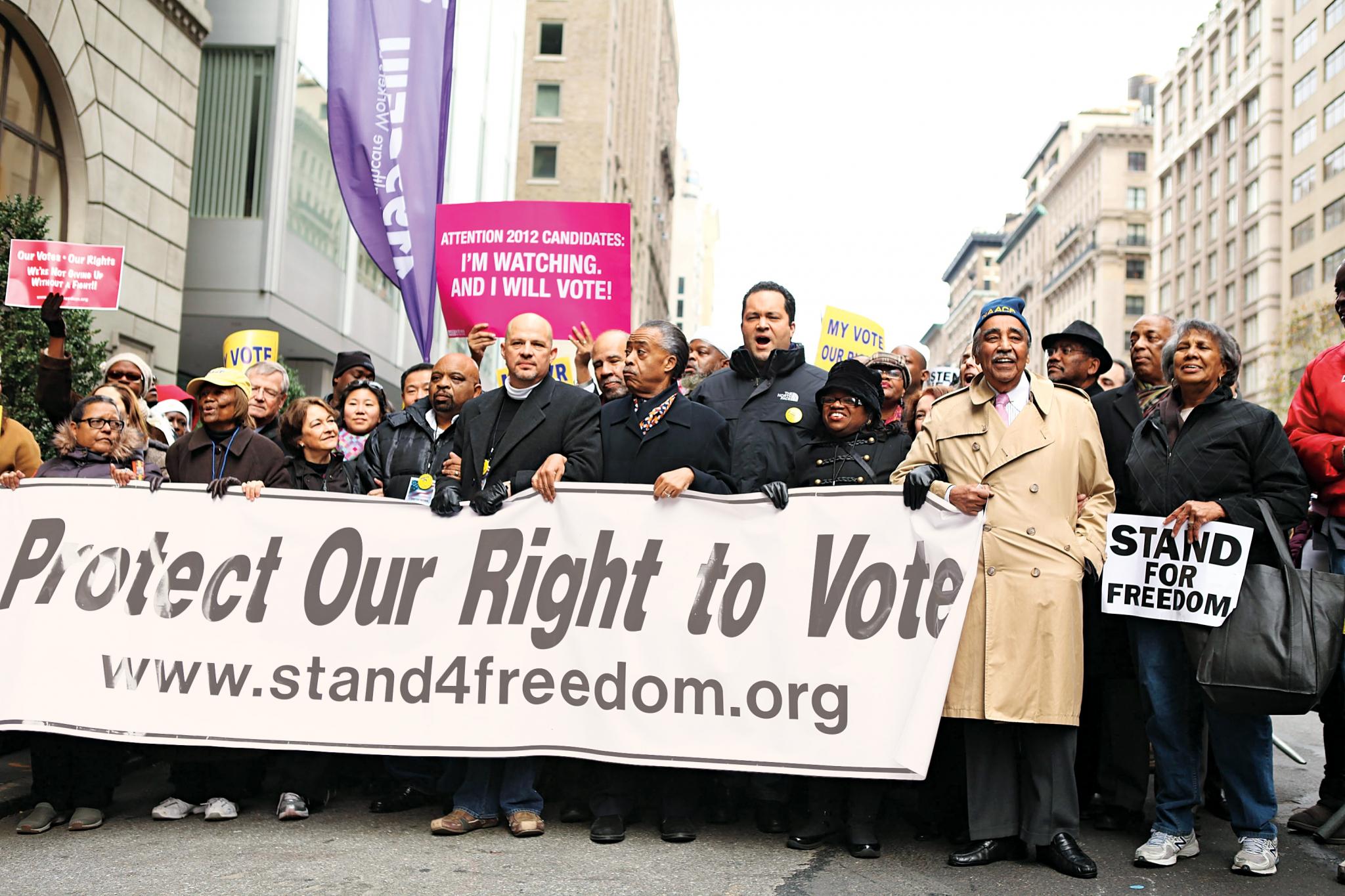
Rosanell Eaton was born on her family’s farm in Louisburg, North Carolina, on April 14, 1922. As soon as she became eligible, she asked her mother to take her to the county courthouse so she could register to vote. “There were three men sitting there,” Eaton recalls of her visit to the courthouse. When Eaton explained to them that she’d arrived to register to vote, she says, one man barked, “Stand over there by the wall. Don’t look to the right or the left. Repeat the preamble to the U.S. Constitution. And,” he added, “don’t make any mistakes.” To their surprise, Eaton recited the words like a professional orator.
Back then, such “literacy tests” were commonly used intimidation tactics, especially in southern states, designed to keep African-Americans disenfranchised. But Eaton passed with flying colors. “I was up on history and the Constitution,” she explains when asked how she’d prepared for the inevitable confrontation. “In my high school, you had to learn poems over the weekend and recite them in class. The Constitution wasn’t any big problem.” That year, and in every election thereafter for more than seven decades, Eaton voted by first signing her name to verify her identity and then casting her ballot. For 40 years she even volunteered as a poll worker.
But none of that matters under North Carolina’s new law, the Voter Information Verification Act (VIVA), which requires a photo ID for in-person voting and, at press time, is scheduled to take effect on January 1, 2016. When Eaton shows up to vote in the next presidential election, she’ll present a driver’s license that lists her name as Rosa Johnson Eaton, and that doesn’t match the name that’s currently listed on her voter registration card, Rosanell Eaton. Nor does either name match exactly that given on her birth certificate, which has both a spelling error and contains only her maiden name, Rosa Nell Johnson. Errors such as these are commonplace for people who, like Eaton, were born at home. In those cases, whoever was assisting with the birth, oftentimes women who were illiterate, filled out the certificates themselves.
Under VIVA, seniors over the age of 70 can present an expired photo ID for a limited period of time, but they cannot present one that doesn’t match the name listed on their voter registration card. In order to update her photo ID, Eaton would need to spend a considerable amount of time both correcting her birth certificate and locating a certified copy of her marriage license.
To understand how this turn of events came to be, you have to go back to June 25, 2013, the day the Supreme Court ruled 5–4 to nullify a key part of the landmark 1965 Voting Rights Act known as “Section 5.” Section 5 was a promise from the federal government that it would keep an eye on those mostly southern states, such as Alabama, Mississippi, Georgia and Texas, that had actively terrorized Black people for generations and denied them their constitutional right to vote. These states could make no changes to their voting laws without permission, or “preclearance,” from the Civil Rights Division of the U.S. Department of Justice. In short, Section 5 protected us from prohibitive laws motivated by racial bias. According to a report in June by the Brennan Center for Justice at New York University, during one recent six-year period before Section 5 was made irrelevant, 262 voting changes from mostly southern states were withdrawn or altered after the DOJ asked for more information. Now, that protection has disappeared.
Since then, Republican-controlled state legislatures have put in place sweeping changes that civil rights advocates say are designed to make voting more difficult for minorities, college students, the poor, the disabled and the elderly—groups that tend to vote Democratic. Currently, 34 states have restrictive voter ID laws. One example is Texas, where, within two hours of the Supreme Court’s decision, Republican Attorney General Greg Abbott announced that a new law would go into immediate effect: In a state where thousands of eligible voters attend historically Black colleges, university students can no longer present college IDs to vote (but a license for a concealed handgun is just fine). Women, who made up 53 percent of voters in the 2012 elections according to the Center for American Progress, also stand to be affected. Many new laws stipulate that voter and state IDs (such as a driver’s license) must bear the exact name, which poses a huge problem for women who show up to the polls after a marriage or divorce. The Brennan Center says this could inhibit the voting rights of 34 percent of women who lack citizenship documents with their current legal name.
“We have a war going on in this country,” explains Penda D. Hair, codirector of the Advancement Project, a civil rights organization at the forefront of the voting rights struggle. There is a Republican “playbook” being trotted out in state after state, she says, and it has been consciously designed to manipulate the rules in order to keep certain groups from voting. The tim- ing is critical given the surge of minority voters who turned out for the 2008 and 2012 presidential elections and the Republican party’s ongoing failure to win over African-Americans and Latinos. “There are some who want our democracy to expand,” adds Leah Aden, assistant counsel for the NAACP Legal Defense Fund in New York, “and there are others who want to make it less inclusive.
Across the board, these laws have reduced polling hours and early and weekend vot-ing, and put tight restrictions on third-party civil rights groups like Rock the Vote, which has registered some 6 million mostly young voters in the past 25 years. “The big issues like photo ID tend to get a lot of headlines,” says Pratt Wiley, director of voter protection for the Democratic National Committee. “But it’s important to know that there are also smaller changes that can have a big impact, like moving polling locations to places not accessible by public transportation.”
Judith Browne Dianis, codirector of the Advancement Project, adds, “I expect that the closer we get to the presidential election in 2016, the more we’ll see efforts that make it harder to vote.” And as bad as these laws have been so far, they’re nothing, she says, in comparison with what’s happen- ing in North Carolina—the state her organization calls “ground zero” for the voting rights struggle. “It continues to be the most significant battleground,” says Dianis, “because it’s the kitchen sink.” In other words, everything important to African- American voters that could have been reduced or slashed has been: same-day registration, weekend voting, evening voting and early voting. They’ve even eliminated valid out-of- precinct ballots and preregistration for 16- and 17-year-olds. Every one of these cuts, says Dianis, is statistically proven to hurt African-Americans more than Whites. In the 2008 general election in Florida, for example, 33 percent of those who voted early on the last Sunday before Election Day (aided by church buses and popular campaigns like Souls to the Polls) were African-American. In 2012, an astonishing 70 percent of African-Americans who cast a ballot did so by early voting, which is especially useful for those with inflexible work schedules, multiple jobs, child care constraints, transportation issues and other barriers that tend to impact Blacks more so than other groups.
In an e-mailed statement, Rep. David R. Lewis, chair of the State House Elections Committee, maintained that the point of VIVA is “to secure the integrity of North Carolina’s elections process” and that “any ballot cast in error dilutes the votes of those who lawfully cast their ballots.” But Carol W. Davis, co–vice-president of the Orange County League of Women Voters in Florida, insists that such measures are unnecessary since there is no evidence of widespread, in-person voter fraud. In fact, there is more evidence of fraud when it comes to absentee voting, which African-Americans tend not to use since they trust it less than in-person voting. “Minority voters, especially older ones, like going to the precinct and seeing their vote go into the machine,” says Davis. “I think it’s because many can still remember when their vote was suppressed. They want to make sure it’s counted.” In 2012, African-American voters made up 22 percent of registered voters in North Carolina, but were only 9 percent of voters who mailed in absentee ballots. To cast an absentee ballot, no ID is required—just the voter’s signature as well as the signatures of two witnesses. And yet, Republican legislators have expanded this method to accommodate those who use it—86 percent of whom were White (in the 2012 presidential election).
From the perspective of Rosanell Eaton, who lived through Jim Crow laws and burning crosses on her family’s land, these restrictive new rules were too much to accept. So at the age of 92, she joined the thousands of North Carolinians who descended on the state capitol in Raleigh last summer to express outrage about voter ID laws and other harsh Republican-led policies harming minorities and the poor. They called these events “Moral Mondays” and for months, their acts of peaceful protest made headlines. Eaton also became a lead plaintiff in a lawsuit filed by the Advancement Project and the North Carolina chapter of the NAACP. A federal judge was expected to rule this summer on whether the new laws discriminate against Black voters and should be blocked before November’s midterm election, but at press time, no decision had been made.
There is some good news, though. In at least three states—Pennsylvania, Wisconsin and Arkansas—groups like the Advancement Project, the NAACP, the League of Women Voters, the ACLU and other civil rights advocates have fought back in state courts and successfully blocked these laws from being enacted. “In Pennsylvania we were able to show that the system for getting voter IDs was chaotic,” says Hair, “probably intentionally so.” The courts agreed, calling that state’s voter ID law unconstitutional and throwing it out (as did a judge in Arkansas). In Wisconsin, Anita Johnson, a community organizer for Citizen Action of Wisconsin, traveled to hundreds of churches, senior centers and schools last year to educate voters about the changes in her state. She found widespread confusion: Some voters had expired licenses and couldn’t get the necessary documentation to renew them; others couldn’t get to the DMV, or couldn’t afford the cost of a certified birth certificate.
“Sometimes I had two or three churches to go to on a Sunday morning,” Johnson recalls. “If I couldn’t speak at the service, I would go to a prayer meeting. I went anywhere they gave me a platform.” At a Milwaukee home for seniors, Johnson offered to take an 87-year-old man to the courthouse to get his birth certificate so that he could vote under the new law. “I thought it would be quick,” she says. It wasn’t. The clerk told them that there was no record of the man’s birth and that he would have to travel 80 miles east to Madison and pay for a “delayed birth certificate.” The office of vital records also wanted verification that he’d attended school where he said he had in Milwaukee, at the age of 7. Eventually, Wisconsin’s voter ID laws were struck down as being racially discriminatory. The state plans to appeal the decision.
Despite these victories, the fight is far from over—some-thing that Davis knows firsthand. In 2011, she and her husband were responsible for signing up 1,500 of the Orange County League’s registrants. They went to schools, career fairs, farmers’ markets and PTA meetings. Once, while making a quick stop at a fast-food restaurant to get dinner, Davis says her husband asked the cashier if she was registered to vote. She wasn’t. “Wait just a minute,” he told her, and headed back to their car. He returned with a voter registration form and signed her up then and there. In the past, the Davises have been able to focus their time and energy on registration. Now they’re retooling to educate voters about Florida’s photo ID laws and other changes in voting procedures of which they may not be aware.
Many still remember the 2000 presidential election when some 27,000 Florida ballots were thrown out because of faulty voting machines. “It should come as no surprise that these machines were placed in precincts in predominantly African-American neighborhoods,” says Congresswoman Corrine Brown, whose district was impacted. “During that same election year,” says Brown, “Governor Jeb Bush spent $4 million in tax dollars to purge 40,000 suspected felons from the voter rolls, even though many were eligible and wrongfully removed. I think there’s a definite, organized effort to disenfranchise voters,” she adds.






Still, says Dianis, “the Black community as a whole doesn’t understand the power of the vote,” especially in state and local elections for school boards, city councils, state attorneys and judges. These are the people paying for private prisons and closing public schools, and we’re not showing up to stop them. “Yes, our voter participation was up in 2012,” she says, “but when you step back from a presidential election, our numbers are abysmal. We have millions of people who aren’t even registered.”
“Average citizens need to become familiar with the issues in their state,” says Davis. “One way to do that is to join a civic organization, like the NAACP, the Urban League or the National Council of Negro Women. On college campuses, the student governments, fraternities and sororities can also be good places to start.” The national leadership of the NAACP is heavily engaged in a battle to get a new Voting Rights Amendment Act, proposed in 2014, through Congress, and is asking people to contact their congressional members and senators to voice their concern. Locally, in places like Texas, voting rights advocates are being asked to write to vote@naacpldf.org, according to the NAACP’s Aden, where that organization is compiling and documenting the voting problems people have experienced since the end of Section 5. “There’s a civil rights legacy that we have to protect,” Dianis says. Now, the question is, will we continue to fight for it?
This article was originally published in the September 2014 issue of ESSENCE magazine, on newsstands now.







